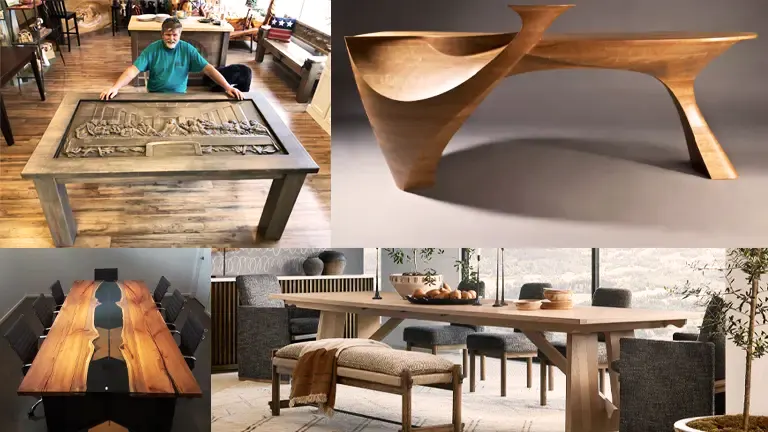Guide to Custom Furniture: From Sketch to Finish
- July 28, 2023
- 0 comment
Custom furniture holds a special allure that mass-produced pieces can never replicate. Crafted with love, attention to detail, and the individual’s specific needs in mind, custom furniture becomes an extension of one’s personality and style. In this comprehensive guide, we will delve into the art of creating custom furniture, taking you through every step, from the initial sketch to the final finish.

Understanding the Design Process
The journey of custom furniture begins with a clear understanding of the client’s needs and objectives. Whether it’s a bespoke dining table or a unique bookshelf, gathering inspiration and ideas is crucial. By combining the client’s vision and the woodworker’s creativity, design plans are sketched, ensuring that every detail is accounted for. The right selection of materials plays a vital role in transforming the vision into reality.

Tools and Equipment
Before embarking on the woodworking journey, familiarizing yourself with the essential tools is essential. From the trusty saw to the versatile chisel, acquiring the proper tools ensures precise craftsmanship. Safety precautions should never be overlooked, as woodworking involves handling sharp tools and powerful machinery.

Selecting the Perfect Wood
The soul of any custom furniture piece lies in the wood chosen for its creation. Understanding the characteristics of different wood types helps in matching the right material to the project. Additionally, considering sustainability and eco-friendly options is becoming increasingly important in the woodworking community.

Mastering Joinery Techniques
The strength and longevity of custom furniture heavily depend on the joinery techniques used. This section of the guide will cover an overview of common joinery methods and provide step-by-step instructions to master popular techniques. By choosing the appropriate joinery, woodworkers can ensure their creations stand the test of time.

Working with Measurements and Precision
Accurate measurements are the backbone of any successful woodworking project. This section will delve into the techniques for precise measuring and marking, preventing errors that can lead to costly mistakes. Emphasizing the importance of precision, we’ll explore the impact it has on the overall quality of custom furniture.

Shaping and Carving
Elevating the design with intricate patterns and designs is an art form in itself. This segment of the guide will introduce aspiring woodworkers to various shaping and carving techniques. By adding artistic touches, custom furniture transcends utility to become an exquisite masterpiece.

Assembling the Furniture
With components in hand, it’s time to put them all together. This section offers a step-by-step guide to assembling custom furniture with ease and efficiency. Attention to stability and durability is paramount to ensure the piece will withstand the test of time and regular use.

Sanding and Finishing
Smoothness and finesse are the hallmarks of well-crafted custom furniture. We’ll explore the significance of proper sanding techniques and delve into different finishing options, ranging from natural oils to protective varnishes. A flawless finish adds a professional touch, making the piece truly shine.

Personalization and Customization
One of the joys of custom furniture lies in its personalization. We’ll discuss how to incorporate personal touches and cater to specific client preferences, making each piece unique and special.

Personalization and customization are two key elements that set custom furniture apart from mass-produced pieces. These aspects allow woodworkers to infuse a sense of individuality and uniqueness into each furniture creation, catering specifically to the needs and preferences of their clients. Let’s explore these aspects further:
1. Tailored Design:
When crafting custom furniture, woodworkers work closely with their clients to understand their lifestyle, aesthetic preferences, and functional requirements. This collaborative process allows for a tailored design that perfectly fits the client’s space and complements their existing decor. Unlike generic furniture, which may not fit well or match the desired style, personalized pieces are meticulously designed to meet the client’s exact specifications.
2. Material Selection:
Custom furniture offers the flexibility to choose from a wide range of materials, including different types of wood, metal accents, upholstery fabrics, and more. Clients can handpick the materials that resonate with their taste, ensuring that the final piece aligns with their vision. This level of material selection empowers clients to create furniture that reflects their personality and creates a cohesive ambiance in their living spaces.
3. Artistic Touches:
Woodworkers can incorporate artistic touches and intricate details into custom furniture that elevate its aesthetic appeal. Whether it’s hand-carved patterns, inlaid designs, or unique joinery, these artistic elements add an extra layer of beauty and charm to the piece. This creativity allows clients to own furniture that goes beyond functionality and becomes an exquisite work of art.
4. Size and Proportions:
Custom furniture enables clients to overcome the limitations of standard sizing. For those with unique room dimensions or specific spatial constraints, custom pieces can be crafted to fit perfectly within the available space. Moreover, clients can dictate the proportions of the furniture, ensuring that it complements other elements in the room and creates a harmonious environment.
5. Signature Features:
Incorporating signature features is another way to personalize custom furniture. Woodworkers can add small, distinctive elements that define their style and craftsmanship. These unique touches become a hallmark of the artisan’s work and resonate with clients who appreciate the artistry and attention to detail.
6. Functional Customization:
Beyond aesthetics, custom furniture also caters to functional customization. Clients can request specific features or functionalities that suit their lifestyle. For example, a dining table can be designed to include hidden storage compartments, or a desk can have built-in cable management solutions. This level of functionality ensures that the furniture not only looks beautiful but also serves its intended purpose seamlessly.
7. Emotionally Meaningful Pieces:
Custom furniture has the potential to become emotionally meaningful to clients. It may carry sentimental value, representing a special moment, a gift from a loved one, or an heirloom to be passed down through generations. The emotional connection formed with personalized furniture enhances its value and appreciation over time.
Quality Control and Inspection
Before delivering the finished custom furniture, a meticulous quality control process is conducted. Visual assessment, structural integrity, fit and finish, functionality testing, and material quality are thoroughly reviewed. Any identified imperfections are addressed to ensure the piece meets the highest standards of craftsmanship and client satisfaction.
Delivery and Installation
With the piece ready to meet its new home, it’s essential to ensure safe transportation and installation. Proper handling ensures the furniture arrives at its destination intact and ready to be admired.

Maintenance and Care Tips
Educating clients on how to care for their custom furniture is a thoughtful gesture. We’ll provide tips on maintenance and cleaning to preserve the beauty and integrity of the piece for years to come.

Showcasing Your Masterpiece
Lastly, we’ll explore the significance of showcasing your masterpieces. Building an online portfolio or store allows your work to reach a wider audience and promotes the craftsmanship of custom furniture-making.
Conclusion
Crafting custom furniture is an art that requires passion, skill, and dedication. With this ultimate guide, we hope to inspire aspiring woodworkers to embark on this fulfilling journey. From sketching the initial design to applying the final finish, the process of creating custom furniture is as rewarding as the final product itself. Embrace your creativity, explore various techniques, and watch as your custom furniture pieces become cherished treasures in the homes of your clients. Happy woodworking!

John Carlos
Forestry AuthorThe beauty of logging isn't just about felling trees. It's about understanding nature, mastering the art of chainsaws, and respecting the environment. I believe in sharing my experiences and knowledge, ensuring that we move towards a sustainable future together.













Leave your comment